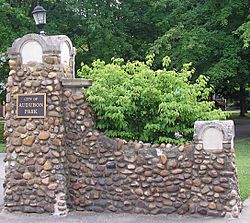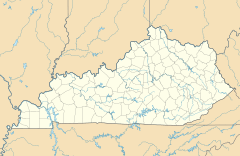Audubon Park, Kentucky facts for kids
Quick facts for kids
Audubon Park, Kentucky
|
|
|---|---|

Entrance pillars to Audubon Park
|
|

Location of Audubon Park in Jefferson County, Kentucky
|
|
| Country | United States |
| State | Kentucky |
| County | Jefferson |
| Area | |
| • Total | 0.32 sq mi (0.84 km2) |
| • Land | 0.32 sq mi (0.84 km2) |
| • Water | 0.00 sq mi (0.00 km2) |
| Elevation | 505 ft (154 m) |
| Population
(2020)
|
|
| • Total | 1,433 |
| • Density | 4,422.84/sq mi (1,708.66/km2) |
| Time zone | UTC-5 (Eastern (EST)) |
| • Summer (DST) | UTC-4 (EDT) |
| ZIP Code |
40213
|
| FIPS code | 21-02656 |
| GNIS feature ID | 2403136 |
|
Audubon Park Historic District
|
|
| Lua error in Module:Location_map at line 420: attempt to index field 'wikibase' (a nil value). | |
| Location | Roughly bounded by Hess Ln. and Cardinal Dr. between Eagle Pss and Preston St., Audubon Park, Kentucky |
| Area | 230 acres (93 ha) |
| Built | 1912 |
| Architect | G. Robert Hunt; Harmon and Co. |
| Architectural style | Tudor Revival Colonial Revival Bungalow/Craftsman |
| MPS | Louisville and Jefferson County MPS |
| NRHP reference No. | 96000430 |
| Added to NRHP | April 18, 1996 |
Audubon Park is a small city in central Jefferson County, Kentucky, United States. It's a "home rule-class city," which means it has the power to manage its own local affairs. In 2020, about 1,433 people lived there. Audubon Park is located about 5 miles (8 km) south of downtown Louisville and is completely surrounded by the city of Louisville.
Contents
History of Audubon Park
Audubon Park began as a residential area in the early 1900s. The land, about 230 acres (0.93 km²), used to be hilly pasture. It was once owned by General William Preston, who received it in 1774 from the British government for his service during the French and Indian War.
How Audubon Park Was Developed
In 1906, G. Robert Hunt bought the land. An enthusiastic golfer named Russell Houston then built the Audubon Park Country Club there. In 1912, the Audubon Park Realty Co. bought the land. They decided to name the new neighborhood after John James Audubon, a famous wildlife painter. A fun fact is that almost all of the city's 20 streets are named after birds!
Development was quite slow at first. But in the 1920s, Louisville Gas and Electric installed gas lines and streetlights. After that, new houses were built very quickly, with one starting almost every two weeks. Most of the homes have traditional designs, like Neo-colonial and Dutch colonial styles. You can also find some California bungalows, which are a type of Craftsman-style house.
Transportation and Incorporation
An early streetcar line used to run to a station house near the center of the park. This station house is now a private home. The streetcar line stopped running in the 1920s, but the tracks weren't fully removed until 1975. Audubon Park officially became a city in 1941, thanks to the state assembly.
Unique Features and Traditions
The city is known for its straight, tree-lined streets. This is partly because utility lines (like power and phone) are often placed behind the houses. Audubon Park also has six small neighborhood parks. Its entrances are marked by large, impressive stone gateways. The city has two special yearly events: a spring dogwood festival and a fall Arts and Crafts festival. Because of its unique history and architecture, the city was added to the National Register of Historic Places in 1996.
Geography
Audubon Park covers a total area of about 0.32 square miles (0.84 square kilometers). All of this area is land.
Population and People
| Historical population | |||
|---|---|---|---|
| Census | Pop. | %± | |
| 1950 | 1,790 | — | |
| 1960 | 1,867 | 4.3% | |
| 1970 | 1,862 | −0.3% | |
| 1980 | 1,571 | −15.6% | |
| 1990 | 1,520 | −3.2% | |
| 2000 | 1,545 | 1.6% | |
| 2010 | 1,473 | −4.7% | |
| 2020 | 1,433 | −2.7% | |
| U.S. Decennial Census | |||
In 2000, there were 1,545 people living in Audubon Park. There were 619 households, with about 433 of them being families. The average household had about 2.5 people.
The population was spread out by age:
- About 25% were under 18 years old.
- About 6% were between 18 and 24.
- About 24% were between 25 and 44.
- About 27% were between 45 and 64.
- About 17.5% were 65 years or older.
The average age in the city was 42 years.
Climate
The weather in Audubon Park has hot, humid summers and generally mild to cool winters. This type of weather is called a humid subtropical climate. On climate maps, it's often shown as "Cfa."
See also
 In Spanish: Audubon Park (Kentucky) para niños
In Spanish: Audubon Park (Kentucky) para niños



